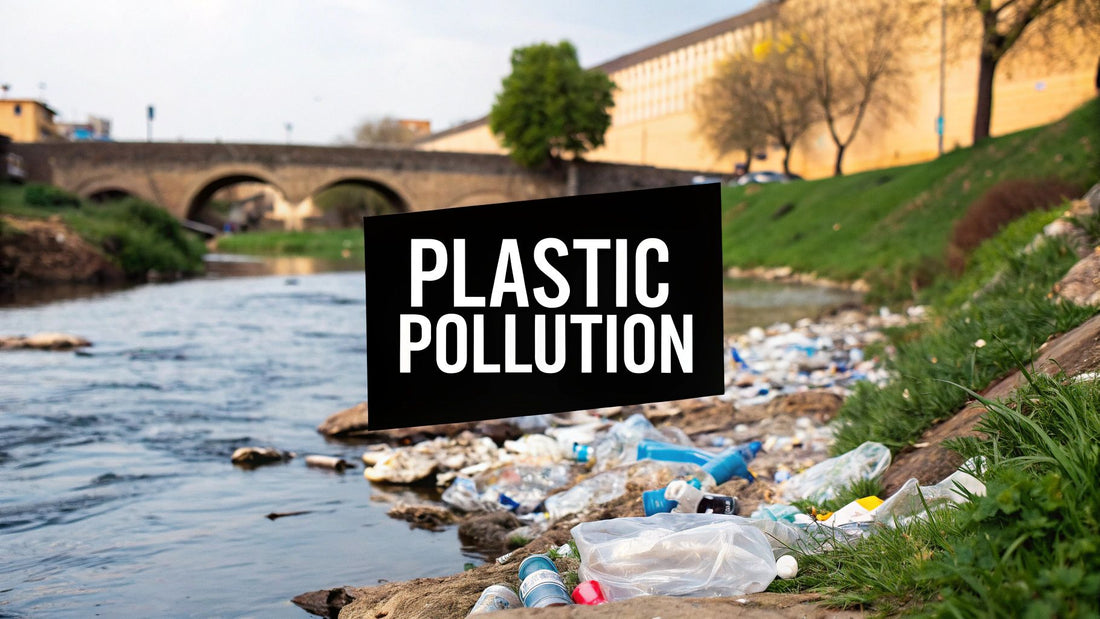
Understanding Plastic Pollution in Water: Causes & Solutions
Share
When you hear "plastic pollution in water," what comes to mind? Maybe a plastic bag floating in the ocean or a bottle washed up on the beach. But the reality is far more pervasive. It’s the buildup of every plastic item imaginable—from massive fishing nets and everyday bottles to microscopic fibers shed from our clothes—in our oceans, rivers, and lakes. This contamination is more than just an eyesore; it harms wildlife, throws entire ecosystems out of balance, and as we’re now discovering, poses a real threat to human health.
The tricky thing about plastic is that it never truly goes away. It just breaks down into smaller and smaller pieces.
The Unseen Flood of Plastic in Our Water
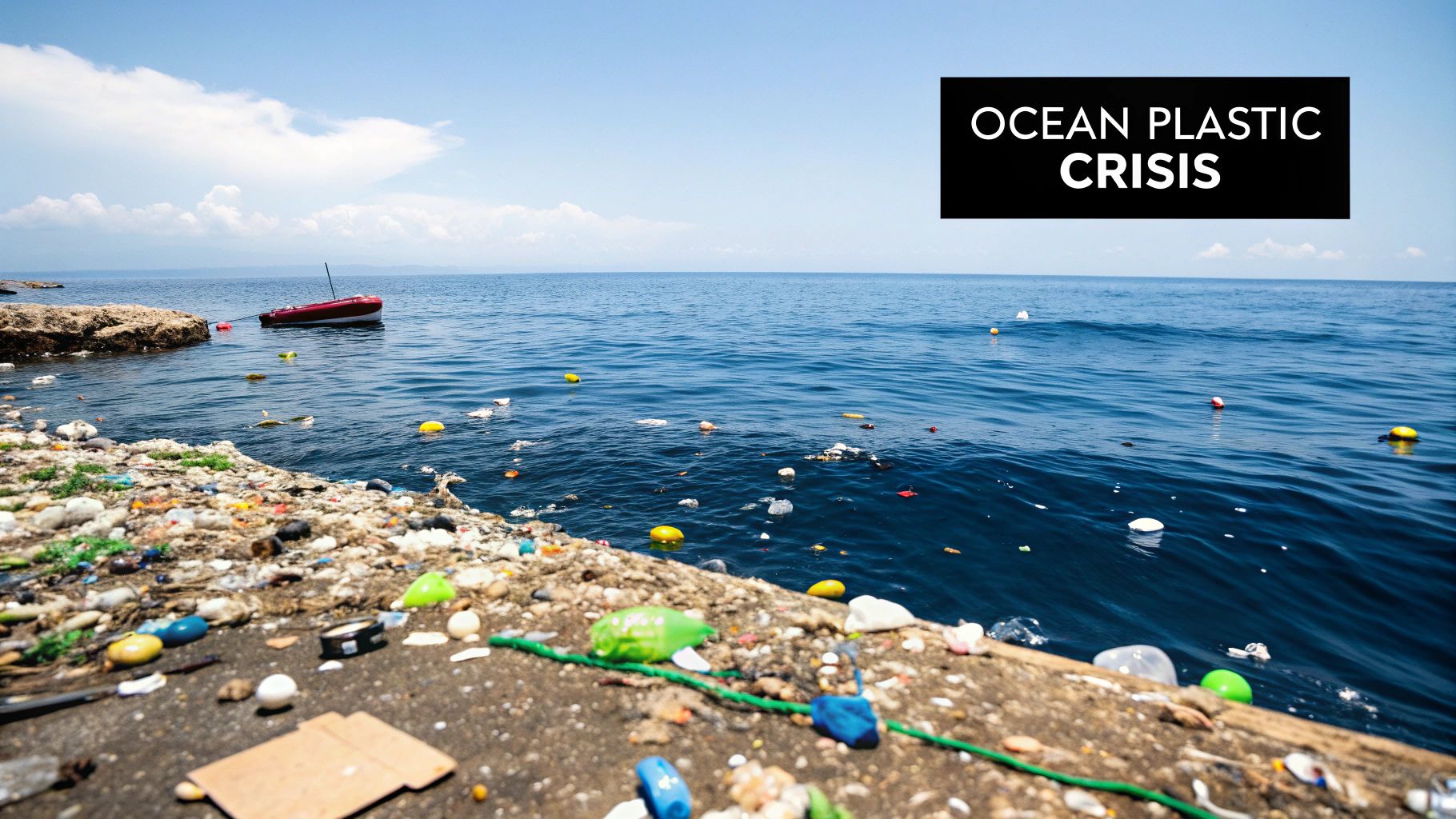
Picture this: 2,000 garbage trucks, lined up and ready to go. Every single day, they dump their entire plastic cargo directly into the world’s oceans, rivers, and lakes. It sounds like something from a disaster movie, but it's the stark reality we're facing. This daily flood is the source of the plastic pollution in water we see choking our coastlines and swirling in enormous ocean garbage patches.
Annually, a staggering 19 to 23 million tonnes of plastic waste find their way into aquatic environments. This relentless stream poisons the very water systems that all life on Earth, including us, depends on. You can explore more data on this global issue to see just how these staggering figures break down.
From Our Hands to the High Seas
So, how does it all get there? The journey of a plastic item is often long and, frankly, destructive. A plastic bottle carelessly dropped on a city street doesn't just sit there. The next time it rains, that bottle is swept into a storm drain, starting a long trip through our complex water systems. Our rivers then act like superhighways, carrying waste from hundreds of miles inland straight out to sea.
This guide will go beyond the overwhelming numbers to tell the real story of plastic pollution. We'll trace the path of everyday items from land to sea, uncover the devastating impacts on both wildlife and our own health, and, most importantly, explore powerful and practical solutions that are already making a difference.
The heart of the problem isn't just a littered beach. It's a fundamental breakdown in how we produce, use, and dispose of things—a system that allows this durable material to escape into nature on an unimaginable scale.
Grasping the Scale of the Problem
To have any hope of solving this, we first need to get our heads around its sheer size. This isn't a problem confined to one country or one type of plastic; it's a global crisis with local roots.
To put things in perspective, this table offers a snapshot of the key facts and figures that define the plastic pollution crisis in our water.
Plastic Pollution in Water At a Glance
| Key Metric | Statistic | Primary Source |
|---|---|---|
| Annual Plastic Leakage | 19-23 million tonnes | Mismanaged Waste |
| Daily Plastic Equivalent | ~2,000 garbage trucks | Land-Based Activities |
| Plastic Bottles Purchased | 1 million per minute | Single-Use Consumerism |
| Ocean Plastic Origin | ~80% from land sources | Urban & Industrial Runoff |
These numbers help make the scale of the problem feel more tangible and urgent. From the infamous Great Pacific Garbage Patch to the microplastics now being found in our own tap water, the evidence is all around us. The good news? The path forward is becoming clearer, and this guide will show you not just the crisis, but the solutions we can all be a part of.
Tracing Plastic's Journey From Land to Ocean
Ever wondered how a plastic bottle dropped in a city hundreds of miles inland can end up floating in the middle of the Pacific? It’s a journey that highlights a crucial truth: plastic pollution in water isn’t just a coastal problem. It’s a global issue that starts right in our own neighborhoods.
The path from a city street to the open sea is surprisingly direct, and our own infrastructure often plays the role of an unwilling accomplice.
Picture a disposable coffee cup lid left on a park bench. A gust of wind or a heavy downpour is all it takes to wash it into the street and down a storm drain. These drains aren't some kind of sophisticated filter; they're often direct entry points to a network of pipes that empty straight into local streams and rivers.
Once in the water, these rivers act like superhighways for plastic trash. They pick up more and more debris along the way—from urban runoff, overflowing landfills near their banks, and industrial discharge. A single piece of plastic can travel for days or even weeks, carried from a small creek, to a major river, and finally, out to the ocean.
The Land-Based Origin of Ocean Plastic
It's a common misconception that most ocean plastic comes from ships or fishing gear. In reality, the overwhelming majority starts its life on land, often far from any coastline. This is a critical point. It means the solutions start with us, in our communities, not just on our beaches.
So, where does it all come from? The primary culprit is breakdowns in our waste management systems.
When landfills are poorly managed or overfilled, lightweight plastic items are easily blown away by the wind, eventually landing in nearby waterways. On top of that, illegal dumping and simple, everyday littering contribute millions of tons of plastic directly into the environment, just waiting for the next rainstorm to carry it away.
This is a breakdown of the primary sources of plastic that ends up polluting our water systems.
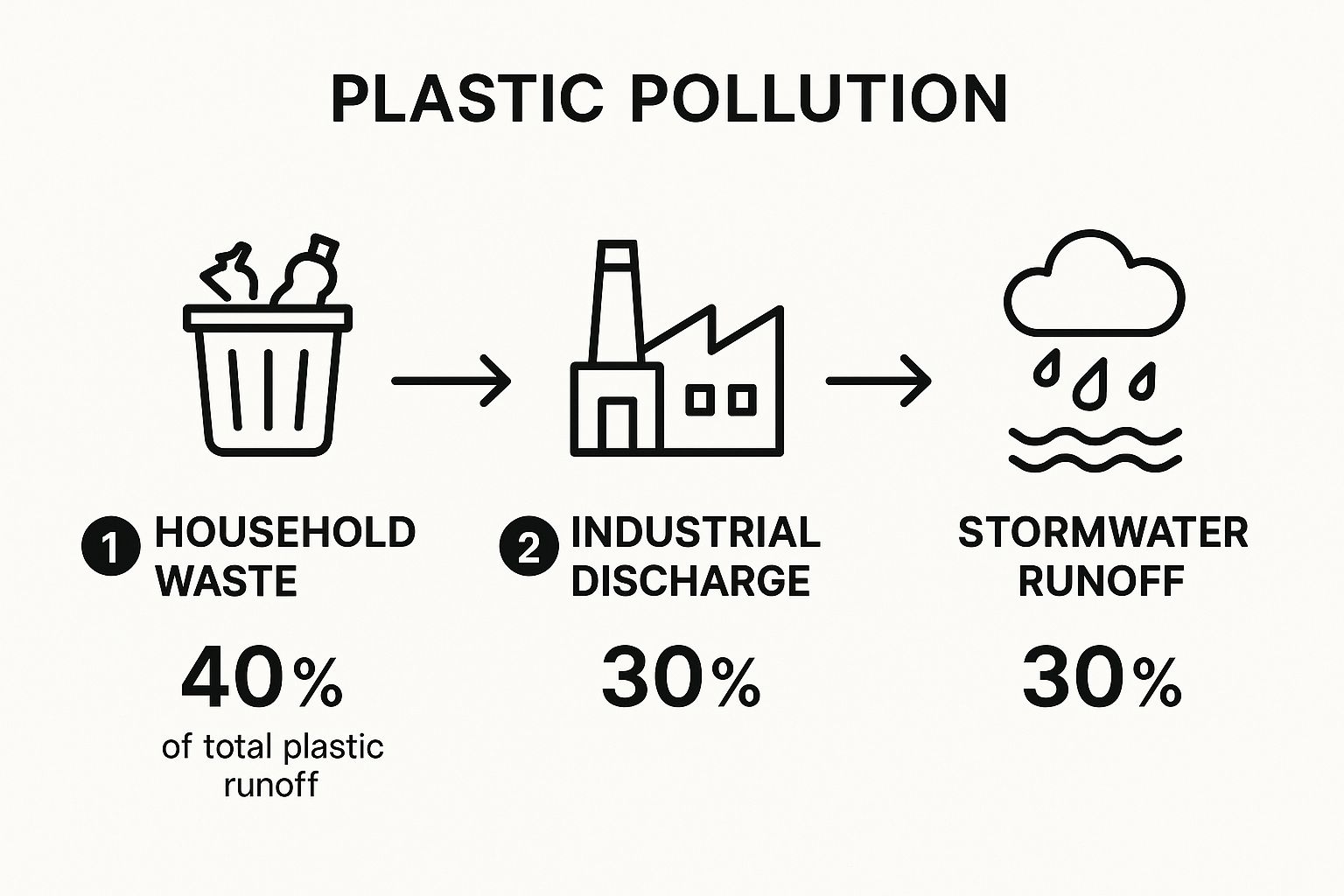
As you can see, household waste and general stormwater runoff account for a staggering 70% of the plastic entering our waterways. This really drives home the powerful role that our daily consumption habits and local infrastructure play in this global crisis.
The River Superhighway Effect
Think of rivers as the planet's circulatory system. Unfortunately, we’ve turned them into conveyor belts for our garbage. An estimated 70% to 80% of all plastic in the ocean got there via rivers. In fact, recent research has pinpointed that just 1,000 rivers around the globe are responsible for carrying nearly 80% of all the plastic that flows into the sea. You can discover more insights about these ocean pollution facts to grasp the scale of the issue.
This "superhighway effect" means our waste management failures inland have direct and devastating consequences for marine ecosystems miles away. It underscores just how important upstream solutions are.
By the time plastic reaches the ocean, the problem has already escalated. The most effective interventions happen long before the trash ever sees the shoreline, focusing on preventing it from entering these riverine pathways in the first place.
The journey doesn't even stop there. Once in the ocean, plastic gets caught in vast, circulating currents called gyres, which can transport it across entire ocean basins. A plastic bag from Southeast Asia could eventually wash up on the coast of North America, breaking down into smaller, more dangerous microplastics along its voyage.
Understanding this complete journey—from a city street, through a storm drain, down a river, and across an ocean—is the first step toward creating real change. It shifts our focus from simply cleaning up beaches to tackling the problem at its source: our over-reliance on single-use plastics and the systemic failures that allow them to poison our shared environment.
The Great Pacific Garbage Patch Explained
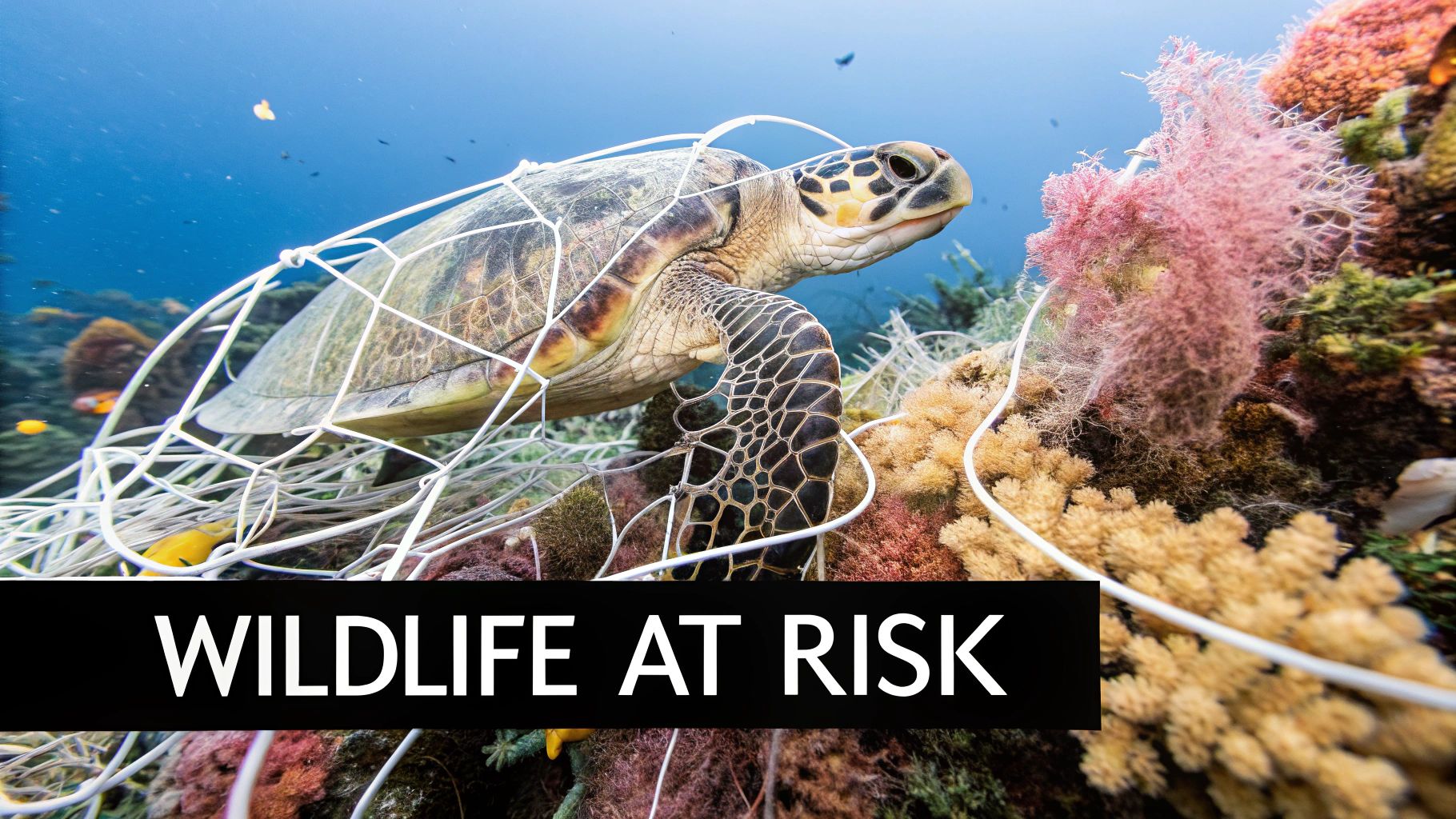
When people talk about plastic in the ocean, many picture a floating island of garbage—a solid raft of trash you could almost walk on. But the truth about the Great Pacific Garbage Patch is far more complex and, frankly, more unsettling.
It's not a single, cohesive landmass. Instead, think of it as a vast, murky soup of plastic, endlessly churning in the middle of the North Pacific Ocean. This "soup" is held together by a colossal, slow-moving vortex of rotating ocean currents.
What Forms These Garbage Patches?
This vortex is what’s known as an ocean gyre. Gyres are a totally natural part of how our planet works, like giant whirlpools that help circulate water and regulate ocean temperatures. There are five major ones across the globe.
The problem is, these powerful currents can't tell the difference between drifting plankton and a plastic bottle cap. They pull in debris from all over the Pacific Rim, from the coasts of Asia to North America, trapping it in a relentless, spiraling dance. Since plastic doesn't biodegrade, it just builds up, year after year.
The Great Pacific Garbage Patch is the biggest and most well-known of these accumulation zones. It’s so massive that it’s actually made of two separate patches—the Western Garbage Patch near Japan and the Eastern Garbage Patch between Hawaii and California. A current flows between them, like a highway for trash.
By 2018, it was estimated to be about three times the size of France, and it's still growing. The scale is just staggering. To put it in perspective, it would take 67 ships working for an entire year just to clean up less than 1% of the patch. You can learn more about the environmental impact of plastic pollution and why these cleanup operations face such an immense challenge.
What Is the Garbage Patch Made Of?
While you will find large, recognizable plastic items floating out there, they are only one piece of the puzzle. The patch is a toxic stew of different kinds of plastic debris.
- Macroplastics: These are the bigger pieces you can see with the naked eye. A huge portion of the patch's weight comes from abandoned fishing gear, often called "ghost nets." You'll also find buoys, crates, plastic bottles, and fragments of all sorts of consumer goods.
- Microplastics: Here’s where it gets truly insidious. Over time, sunlight, waves, and salt break down the larger items into billions, even trillions, of tiny plastic fragments smaller than five millimeters. These particles cloud the water, turning the area into a thick, plastic smog rather than a visible island of trash.
The real danger of the Great Pacific Garbage Patch isn't just the visible trash. It's the trillions of microplastic fragments that have integrated into the marine environment, becoming a permanent, toxic part of the ecosystem that is nearly impossible to remove.
The makeup of the patch is always shifting. New waste arrives daily on the currents, while larger pieces break down into smaller ones or sink to the ocean floor. This constant state of flux makes studying and tackling the problem incredibly difficult.
It’s a sobering reminder that our focus can't just be on what's already out there. The real mission has to be stopping plastic from ever reaching our waterways in the first place.
How Waterborne Plastic Harms Wildlife and People
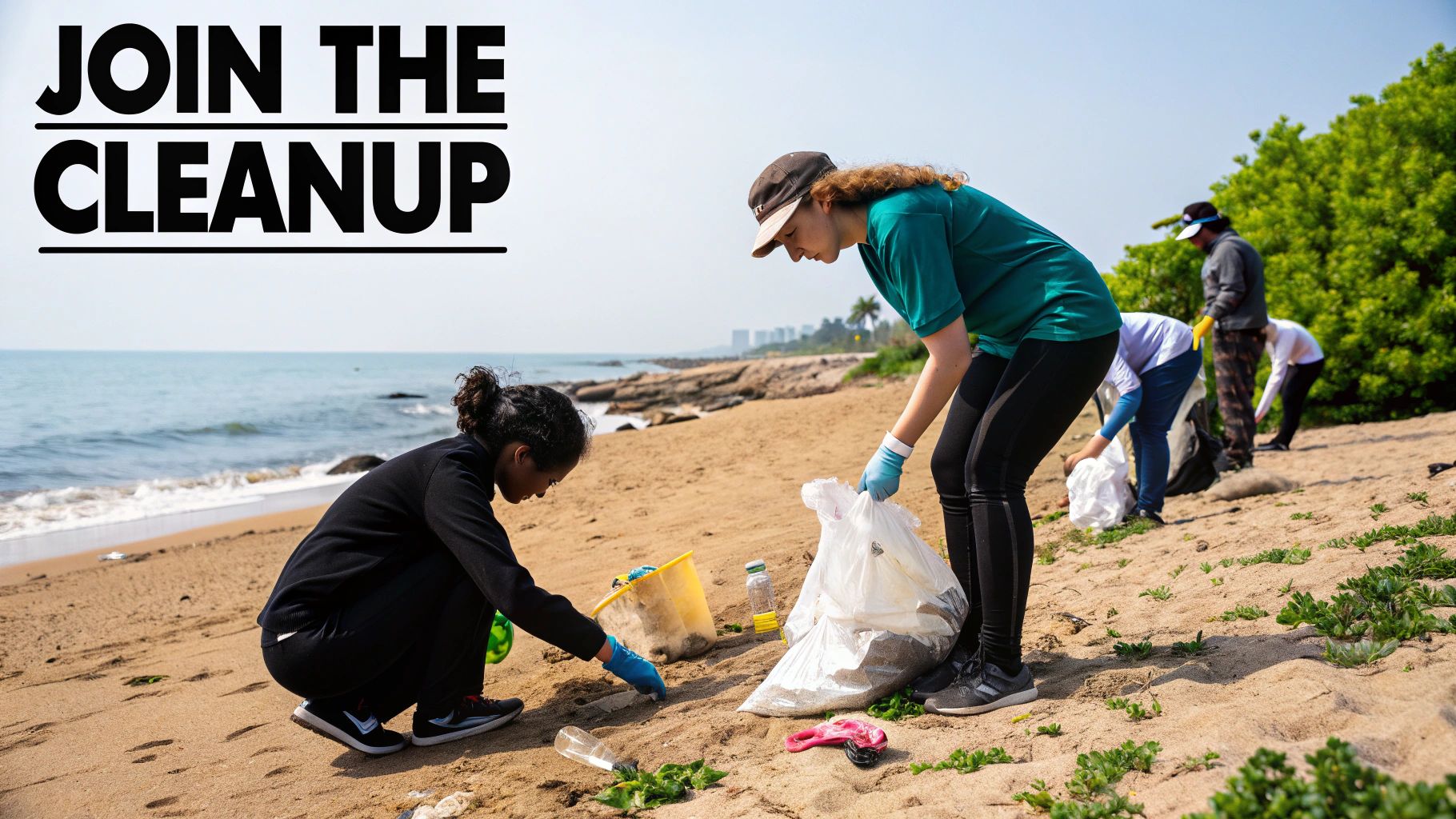
The fallout from plastic pollution in water goes far beyond messy beaches. For wildlife, plastic debris is a direct, daily threat, turning their natural homes into a minefield of human garbage. From the largest whales to the tiniest plankton, no corner of the marine world is untouched.
The most obvious harm comes from macroplastics—the big, recognizable stuff like bags, bottles, and lost fishing gear. For animals, these items pose two immediate dangers: entanglement and ingestion.
First-hand accounts from researchers paint a grim picture. They find whales with digestive systems completely blocked by plastic balloons and sea turtles that mistook floating plastic bags for jellyfish, their favorite food. It's a case of mistaken identity with fatal consequences.
The Ecological Toll on Marine Life
The damage to marine animals is heartbreaking, but it's also systemic, affecting entire populations in deeply concerning ways.
Take sea turtles, for example. One study of loggerheads in the Mediterranean found that nearly half had plastic in their stomachs. A single turtle had swallowed 67 different plastic pieces. This isn't a rare occurrence; it’s a modern tragedy. When a turtle eats buoyant plastic like bottle caps, it can throw off their ability to dive for food, essentially leading to a slow, agonizing starvation.
Seabirds face a similarly insidious threat, so much so that scientists have had to coin a new term for the disease it causes: plasticosis.
- What is Plasticosis? As plastic breaks down, it creates sharp, abrasive fragments. When birds eat these pieces, they cause constant, tiny injuries throughout their digestive tracts.
- How It Harms Them: Over time, this chronic irritation leads to scarring and inflammation, a condition called fibrosis. This scar tissue makes it incredibly difficult for the birds to absorb nutrients from their food, leaving them weak and vulnerable.
Beyond what animals eat, there's the problem of "ghost gear"—lost or abandoned fishing nets that drift aimlessly through the ocean. These nets are indiscriminate killers, trapping everything from small fish and dolphins to seals and massive whales, leading to drowning, starvation, or severe injury.
The twin threats of entanglement and ingestion are devastating marine populations. A single plastic bag or a lost fishing net can continue to harm and kill animals for decades as it drifts through the ocean.
How Plastic Contaminates the Entire Food Web
The danger isn’t just about the plastic we can see. As those larger items break down, they create a pervasive smog of microplastics that seeps into the very foundation of the marine food web.
These tiny particles, often smaller than a grain of rice, are eaten by the smallest organisms, like plankton and krill. Small fish then eat that plankton, collecting the plastic in their bodies. The problem snowballs from there. Larger fish, birds, and marine mammals eat the smaller fish, and the plastic travels up the food chain, becoming more concentrated with each step.
This process is known as biomagnification. It means that top predators, like dolphins and sharks, can end up with dangerously high levels of plastic and its associated toxins in their systems. And this contamination doesn't just stay in the ocean; it makes its way directly onto our plates.
The Human Health Connection
The same microplastics that are wreaking havoc on marine life are now being found inside us. When we eat seafood—especially filter feeders like oysters and mussels—we’re also consuming the tiny plastic bits they’ve ingested from the water.
But it’s not just seafood. Microplastics have been found in a shocking number of everyday items:
- Drinking Water: Both bottled and tap water have shown signs of microplastic contamination.
- Sea Salt: Salt harvested from the ocean often contains microscopic plastic fibers.
- Beer and Honey: Even these products can contain microplastics, likely introduced from the air and water used in their production.
These particles are getting into our bodies, and while scientists are still scrambling to understand the long-term health consequences, the early findings are alarming. Chemicals that leach from plastics, like BPA and phthalates, are known endocrine disruptors. They have the potential to interfere with our hormones, metabolism, and even reproductive health.
The journey of a plastic bottle from a store shelf to the ocean and potentially back into our bodies makes the crisis of plastic pollution in water a deeply personal one.
Practical Ways We Can Solve Plastic Pollution
Staring down the reality of plastic in our water can feel a little daunting, but that's not where the story ends. Thankfully, a powerful and practical wave of solutions is gaining steam all over the world. To truly get a handle on this crisis, we need a multi-pronged approach that blends our own choices, corporate innovation, and smart government action.
Think of it this way: the fight against plastic pollution isn’t about finding one silver bullet. It's more like building a defense system with three distinct, interlocking layers. The first layer is us—our daily habits and the things we do in our communities. The second is forged by businesses that are stepping up and rethinking their responsibilities. The final, and arguably most powerful, layer is created by strong policies and international cooperation. When all three work together, we create a truly formidable barrier against the plastic tide.
Starting With Individual and Community Action
Real, lasting change almost always starts small, with the choices we make every single day. When we consciously move away from single-use plastics, we're sending a clear signal to the market that we want something better. Look at your daily routine as a series of small but significant votes for a healthier planet.
Every time you grab a reusable water bottle instead of a plastic one, or remember to bring your own bags to the store, you're casting one of those votes. It might seem small, but when millions of us do it, those actions create a powerful ripple effect that pushes entire industries to change.
Here are a few practical things you can do right now:
- Conduct a Plastic Audit: For one week, just pay attention to your trash can. What are the most common single-use plastics you're tossing out? Food wrappers, takeout containers, and drink bottles are often the biggest culprits. This simple exercise gives you a clear target to aim for.
- Embrace Reusables: Make a one-time investment in some quality, reusable gear. Think coffee cups, water bottles, shopping bags, and food containers. This single shift can prevent thousands of plastic items from ever entering the waste stream.
- Support Local Cleanups: Getting involved in a cleanup at a local beach, river, or park delivers immediate, visible results. It’s also a fantastic way to raise awareness in your community and build a shared sense of ownership over our local environment.
The Critical Role of Corporate Responsibility
While our individual choices lay the groundwork, corporations hold the power to supercharge this shift on a massive scale. After all, the plastic problem usually starts with how products and packaging are designed and made. It only makes sense that this is where a huge part of the solution must come from, too.
This means businesses need to move away from the old, linear "take-make-dispose" model and fully embrace a circular economy. In a circular system, waste is designed out of the equation from the very beginning. Materials are meant to be reused, repaired, or safely returned to nature.
A truly circular economy for plastics means that a plastic bottle wouldn't just be recycled into a park bench; it would be designed from the start to become another bottle, again and again, keeping the material in a closed loop and out of our oceans.
This isn't just a theory; forward-thinking companies are already adopting these strategies. For a wider look at solutions that go beyond just plastic, you can explore some effective strategies to stop water pollution that cover a whole range of environmental actions.
Comparing Solutions to Plastic Pollution in Water
To get a clearer picture of how these different efforts fit together, let's compare them. This table breaks down the main approaches, highlighting their impact, scale, and who needs to be involved to make them happen.
| Solution Type | Primary Action | Scale of Impact | Key Actors |
|---|---|---|---|
| Individual & Community | Reduce, reuse, participate in cleanups. | Local & Cumulative | Citizens, community groups, schools. |
| Corporate Responsibility | Redesign products, invest in recycling tech, adopt circular models. | Regional & National | Businesses, manufacturers, retailers, innovators. |
| Government & Global | Implement bans, set EPR policies, forge international treaties. | National & Global | Governments, international bodies (e.g., UN), NGOs. |
As you can see, no single group can solve this alone. True progress happens when the demand from individuals, the innovation from corporations, and the direction from governments all align.
Government Policies and Global Agreements
The final, essential layer of the solution is government action. Policies and regulations are what create the large-scale, systemic change required to finally turn off the plastic tap. These rules level the playing field, making sure all companies and citizens are held to a higher environmental standard.
We're already seeing a growing number of governments stepping up in powerful ways:
- Plastic Bans: Many countries and cities have put bans on specific, problematic single-use items like plastic bags, straws, and styrofoam. These have been incredibly effective—the UK saw a staggering 98% drop in plastic bag use after introducing a small fee.
- Extended Producer Responsibility (EPR): These are smart policies that make manufacturers financially responsible for their products' entire lifecycle, including what happens after consumers are done with them. This gives companies a powerful incentive to design products that are easier to reuse and recycle.
- International Treaties: Plastic pollution doesn't respect borders, so the world is coming together to fight it. The UN's High Ambition Coalition to End Plastic Pollution is a landmark effort, working to create a legally binding global treaty to stop plastic pollution by 2040.
Common Questions About Plastic Pollution Answered
After seeing the sheer scale of the plastic problem, it's easy to feel overwhelmed. But with that awareness comes questions, and getting clear answers is the first step toward making a real difference.
Let's break down some of the most common things people wonder about.
What's the Real Difference Between Macroplastics and Microplastics?
It helps to think of it like rocks and sand. A big rock is obvious and can cause immediate damage if it falls, but sand gets everywhere, into every crack and crevice, and is much harder to clean up.
Macroplastics are the big, visible "rocks" of the plastic world. We're talking about things you can easily see and pick up: plastic bottles, discarded fishing nets, shopping bags, and takeout containers. Anything larger than five millimeters fits this category. These are the pieces responsible for the heartbreaking images of turtles tangled in six-pack rings or birds mistaking bottle caps for food.
Microplastics, then, are the "sand." They're tiny fragments, often invisible to the naked eye, that break off from those larger pieces over time, worn down by sun, salt, and waves. This is the plastic that gets ingested by the smallest creatures like plankton, working its way up the food chain until it ends up on our plates.
While a floating bottle is a clear problem, it's the trillions of microplastic particles forming a toxic "smog" throughout our oceans that pose a more hidden and widespread threat.
Can We Really Clean Up All the Plastic in the Ocean?
The honest, straightforward answer is no. It’s simply not possible with the technology we have today.
Think about it this way: trying to filter all the microplastics out of the ocean would be like trying to remove all the dust from the air in your entire city. It's an impossibly massive task. Cleanup projects like the ones tackling the Great Pacific Garbage Patch are incredible and necessary, but they can only ever scratch the surface. A huge amount of plastic isn't even floating; it's sunk to the crushing depths of the ocean floor or suspended deep in the water column.
This hard truth brings us to a crucial conclusion: prevention has to be our number one priority. The only way to truly solve this is to stop the plastic from getting into the water in the first place.
What Are the Most Effective Changes I Can Make Every Day?
The problem might be huge, but your daily choices have more power than you think. The most effective changes are often simple habits that, when adopted by many, create a massive ripple effect.
Here are a few high-impact changes you can start with:
- Refuse single-use plastics: This is the big one. Just say "no thanks" to plastic straws, disposable cutlery, and produce bags.
- Embrace reusables: Make a habit of carrying a reusable water bottle, coffee cup, and shopping bags with you. It quickly becomes second nature.
- Buy from bulk bins: Take your own jars and bags to the store for things like rice, nuts, oats, and spices. You'll be amazed at how much packaging you avoid.
- Choose better materials: When you have the option, pick items packaged in glass, metal, or paper over plastic.
These actions send a clear message to manufacturers and cut off the supply of potential pollution at its source.
How Does Plastic-Free Packaging Actually Solve the Problem?
Plastic-free packaging is so critical because it addresses the issue right where it starts. When a company decides to package its goods without plastic, it’s effectively turning off the tap that’s flooding our planet with plastic pollution in water.
By using materials like compostable paper, infinitely recyclable glass, or durable metal, a brand ensures its packaging won't haunt our oceans for centuries. This one shift prevents the creation of future microplastics and eases the burden on our overwhelmed waste systems. It’s a direct, proactive, and powerful way to build a cleaner future for our planet's water.
Tired of your pantry staples coming wrapped in plastic? Naked Pantry delivers high-quality, organic groceries in 100% plastic-free packaging, from compostable bags to reusable glass jars. Make a real impact with every meal by visiting the Naked Pantry website and start building your plastic-free pantry today.
